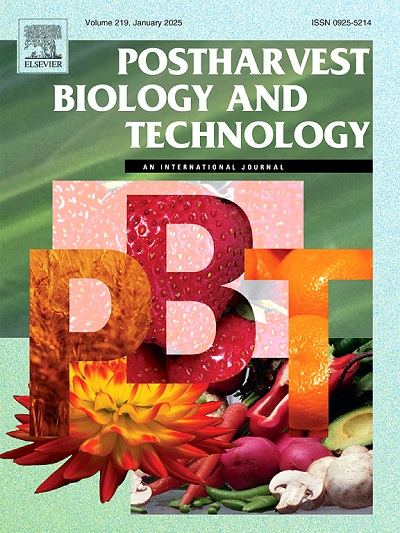Exogenous spermine delays the petal senescence of tree peony ‘Luoyanghong’ cut flowers by affecting physiological and molecular responses
IF 6.4
1区 农林科学
Q1 AGRONOMY
引用次数: 0
Abstract
Tree peony (Paeonia suffruticosa) is an important ornamental plant in China. However, it demonstrates limited postharvest longevity. To investigate the effect of exogenous spermine (Spm) on petal senescence of tree peony cut flowers, we treated ‘Luoyanghong’ cut flowers with 0.1 mmol L⁻¹ Spm. The results indicated that Spm extended the vase time and optimal viewing period of ‘Luoyanghong’ cut flowers by 33 h and 21 h, respectively; reduced malondialdehyde (MDA) content; increased the contents of osmotic regulatory substances and the activity of antioxidant enzymes, including superoxide dismutase (SOD), catalase (CAT), and ascorbate peroxidase (APX); reduced hydrogen peroxide (H2O2) and superoxide anion levels; increased the content of antioxidant substances such as glutathione (GSH), ascorbate oxidase (AsA), total phenols, and total flavonoids; raised the contents of indole-3-acetic acid (IAA) and gibberellic acid (GA3) while decreasing the contents of 6-benzylaminopurine (6-BA), salicylic acid (SA), 1-aminocyclopropanecarboxylic acid (ACC), and abscisic acid (ABA); downregulated the expression of ethylene and abscisic acid biosynthesis and signal transduction genes PsACS, PsEIN3, PsERF1, PsNCED1, PsABA2, PsPYR1, PsABF2 and senescence marker gene PsSAG12 while upregulating the expression of PsCTR1. These results indicated that 0.1 mmol L⁻¹ Spm delayed the petal senescence of tree peony ‘Luoyanghong’ cut flowers and prolonged the postharvest vase life.
外源精胺通过影响牡丹‘洛阳红’切花的生理和分子反应延缓花瓣衰老
牡丹(Paeonia suffruticosa)是中国重要的观赏植物。然而,它的采后寿命有限。为了研究外源精胺(Spm)对牡丹切花花瓣衰老的影响,我们用0.1 mmol L⁻¹ Spm处理“洛阳红”切花。结果表明:Spm可使‘洛阳红’切花的插瓶时间和最佳观赏期分别延长33 h和21 h;丙二醛(MDA)含量降低;渗透调节物质含量增加,超氧化物歧化酶(SOD)、过氧化氢酶(CAT)、抗坏血酸过氧化物酶(APX)等抗氧化酶活性增加;过氧化氢(H2O2)和超氧阴离子水平降低;抗氧化物质如谷胱甘肽(GSH)、抗坏血酸氧化酶(AsA)、总酚和总黄酮含量增加;提高了吲哚-3-乙酸(IAA)和赤霉素(GA3)的含量,降低了6-苄基氨基嘌呤(6-BA)、水杨酸(SA)、1-氨基环丙基羧酸(ACC)和脱落酸(ABA)的含量;下调乙烯和脱落酸生物合成和信号转导基因PsACS、PsEIN3、PsERF1、PsNCED1、PsABA2、PsPYR1、PsABF2和衰老标志基因PsSAG12的表达,上调PsCTR1的表达。结果表明,0.1 mmol L⁻¹ Spm能延缓牡丹“洛阳红”切花的花瓣衰老,延长采后花瓶的寿命。
本文章由计算机程序翻译,如有差异,请以英文原文为准。
求助全文
约1分钟内获得全文
求助全文
来源期刊

Postharvest Biology and Technology
农林科学-农艺学
CiteScore
12.00
自引率
11.40%
发文量
309
审稿时长
38 days
期刊介绍:
The journal is devoted exclusively to the publication of original papers, review articles and frontiers articles on biological and technological postharvest research. This includes the areas of postharvest storage, treatments and underpinning mechanisms, quality evaluation, packaging, handling and distribution of fresh horticultural crops including fruit, vegetables, flowers and nuts, but excluding grains, seeds and forages.
Papers reporting novel insights from fundamental and interdisciplinary research will be particularly encouraged. These disciplines include systems biology, bioinformatics, entomology, plant physiology, plant pathology, (bio)chemistry, engineering, modelling, and technologies for nondestructive testing.
Manuscripts on fresh food crops that will be further processed after postharvest storage, or on food processes beyond refrigeration, packaging and minimal processing will not be considered.
 求助内容:
求助内容: 应助结果提醒方式:
应助结果提醒方式:


